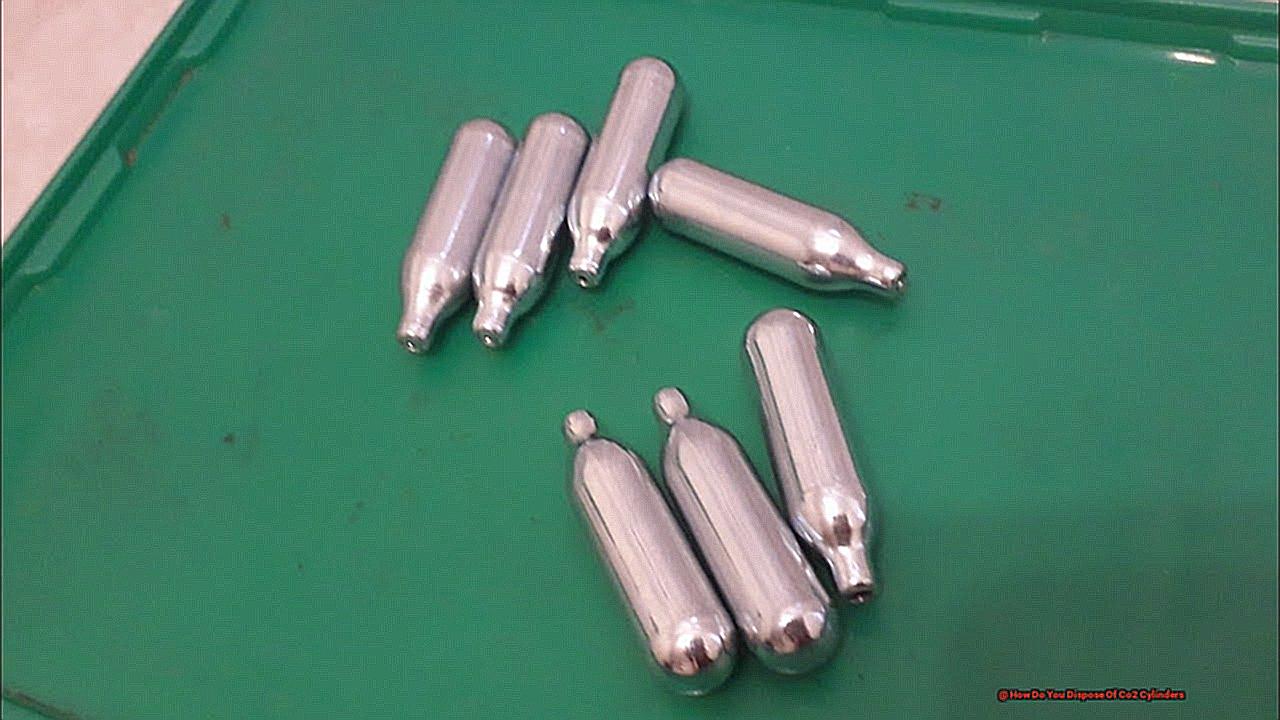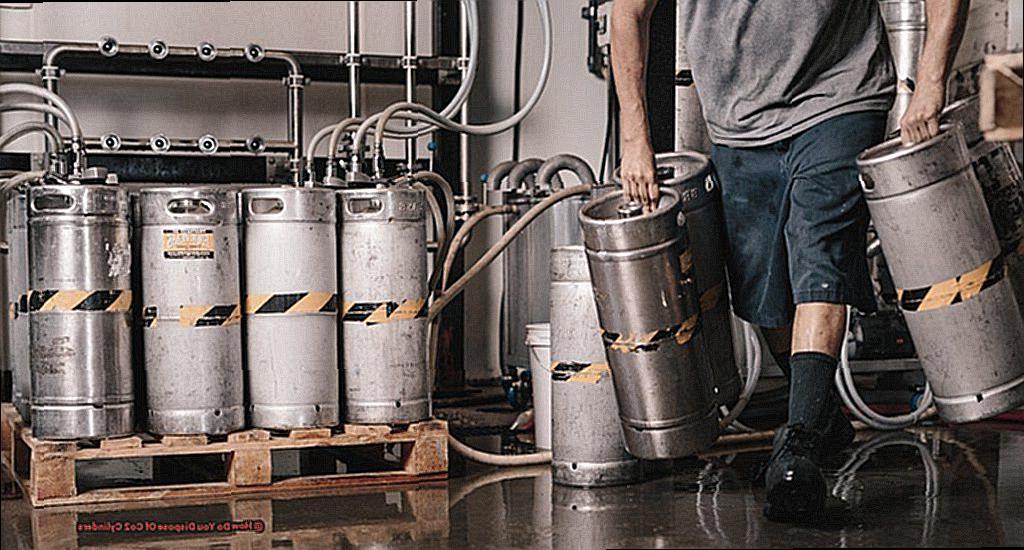Ready to learn about a not-so-glamorous but important topic? Today, we’re talking about the proper disposal of CO2 cylinders.
These little guys may seem harmless, but they pack a punch when it comes to their impact on the environment. Whether you’re a foodie, a medical professional, or just someone who loves fizzy drinks, chances are you’ve encountered these cylinders before.
But do you know how to dispose of them safely and responsibly? In this post, we’ll uncover the ins and outs of disposing CO2 cylinders.
So, let’s roll up our sleeves and get into it.
How Do You Dispose Of Co2 Cylinders?
Contents
- 1 How Do You Dispose Of Co2 Cylinders?
- 2 The Importance of Proper Disposal: Safety and Environmental Concerns
- 3 Step-by-Step Guide: How to Check if a CO2 Cylinder is Empty
- 4 Venting and Depressurization: Essential Steps in Disposing of CO2 Cylinders
- 5 Properly Labeling for Clarity and Safety: What Information Should Be Included?
- 6 Recycling as the Best Option for Disposing of CO2 Cylinders
- 7 Alternative Options for Disposal: Facilities That Offer Professional Services
- 8 Conclusion
Think about all the CO2 cylinders you use or encounter on a regular basis – from the canister that carbonates your favorite soda to the ones used in medical procedures and industrial processes. Have you ever stopped to think about what happens to these pressurized containers after they have served their purpose? Proper handling and disposal of CO2 cylinders is crucial to ensure safety and protect the environment. As an expert on CO2 cylinder disposal, I am here to provide guidance on how to handle and dispose of these containers responsibly.
The first step in disposing of CO2 cylinders is to make sure they are completely empty. This can be done by releasing any remaining gas through the valve or using a regulator to gradually release the gas in a controlled manner. It is vital to follow the manufacturer’s instructions for proper depressurization. Once the cylinder is empty, it should be marked as “empty” or “depressurized” to avoid confusion.
Next, the valve needs to be removed from the cylinder. This can usually be done with a wrench or pliers, but it is crucial to wear protective gloves and eyewear during this process. After the valve has been removed, the cylinder can be recycled. Many recycling centers accept CO2 cylinders, but it is important to check with the specific facility beforehand to ensure they have the necessary equipment to handle them safely.
In cases where recycling is not an option, some companies specialize in proper disposal of hazardous materials, including CO2 cylinders. These companies have the necessary equipment and expertise to safely dispose of these cylinders according to regulations. It is important to note that CO2 cylinders should never be incinerated or thrown in the trash. This can lead to explosions or environmental contamination.
It is also essential to keep in mind that different types and sizes of CO2 cylinders may have different disposal methods. For instance, small disposable CO2 cartridges used in soda makers can typically be safely disposed of in household recycling bins. However, it is crucial to check with local authorities or waste management companies for specific guidelines and regulations.
Proper disposal of CO2 cylinders not only ensures the safety of individuals and the environment but also helps conserve resources. Recycled CO2 can be used for various purposes, reducing the need for new production and minimizing the impact on the environment.
The Importance of Proper Disposal: Safety and Environmental Concerns
Don’t let the small size fool you; CO2 cylinders may seem harmless, but they can be dangerous if not disposed of properly. These pressurized containers are commonly used in various industries and household appliances, but once they’re empty or expired, they can pose serious risks to both individuals and the environment. As an expert on proper disposal methods, it’s my duty to educate you on the importance of responsible disposal and the potential hazards and environmental impacts of improper handling.
First and foremost, let’s talk about safety. CO2 cylinders contain pressurized gas, which can be hazardous if not disposed of correctly. If mishandled or damaged, these cylinders can explode or cause fires, resulting in serious injury or even death. So, when it’s time to dispose of a CO2 cylinder, it’s crucial to follow regulations and guidelines to ensure everyone’s safety.
But that’s not all; improper disposal also has a negative impact on our environment. We all know that CO2 gas is a greenhouse gas that contributes to climate change. Disposing of cylinders in landfills can release this gas into the atmosphere, adding to the already existing pollution. Moreover, residual gas or chemicals in these cylinders can contaminate soil and water sources if not disposed of correctly. As responsible citizens, it’s our duty to protect our planet by disposing of these cylinders responsibly.
So, what are the proper disposal methods? The first step is identifying a damaged or expired cylinder. If you notice any dents, rust, or leaks, do not attempt to use or dispose of it yourself. Contact your local waste management company or a hazardous waste disposal facility for assistance. When transporting a CO2 cylinder for disposal, always handle it with care and keep it upright. It’s also crucial to follow any specific transportation guidelines provided by your waste management company.
Recycling is also an essential aspect of proper disposal. Many companies offer recycling services for CO2 cylinders, which involves safely depressurizing and refilling them for reuse. Not only does this reduce the environmental impact, but it also conserves resources and saves money.

Step-by-Step Guide: How to Check if a CO2 Cylinder is Empty
These seemingly harmless containers may seem small, but they can pose significant hazards if not handled and disposed of correctly. Not only is it crucial for our safety, but it also has a significant impact on our environment.
Before disposing of a CO2 cylinder, it’s essential to check if it’s empty. This step is crucial to ensure safe handling and transportation. So, how do you know if a CO2 cylinder is empty? Let me guide you through the steps.
- Step 1: Remove any attachments or devices connected to the cylinder. This includes regulators, hoses, and adapters. It’s essential to do this before attempting to release any remaining gas.
- Step 2: Release the remaining gas in the cylinder by turning the valve counterclockwise until it stops. It may take a few minutes for all the gas to be released, so be patient. This step should be done in a well-ventilated area for safety reasons.
- Step 3: Once all the gas has been released, remove the valve from the cylinder using a wrench. This step is crucial as it ensures that no gas remains trapped in the valve.
Some cylinders may have a pressure gauge that indicates when the cylinder is empty. If this is the case, make sure to read and interpret the gauge correctly.
Lastly, give the cylinder a good shake or tap it lightly to make sure there are no hissing sounds. If you hear any hissing, it means there is still gas inside, and the cylinder is not empty.
Venting and Depressurization: Essential Steps in Disposing of CO2 Cylinders
Venting and depressurization are essential steps in disposing of CO2 cylinders. These seemingly harmless containers hold pressurized carbon dioxide, making them potentially hazardous if not handled correctly. In this section, we will dive into the necessary precautions and steps to safely vent and depressurize a CO2 cylinder before disposal.
First and foremost, it is crucial to find a well-ventilated outdoor area to dispose of the cylinder. This will prevent any buildup of CO2 gas and reduce the risk of accidents. Once you have found a suitable location, make sure to wear proper safety gear, including gloves, goggles, and a face mask. These will protect you from potential leaks or bursts of gas.
Now, onto the actual venting and depressurization process. Slowly release the gas by turning the valve counterclockwise, being careful not to rush the process. Sudden pressure changes could cause the cylinder to burst, so it is essential to do this gradually. Also, make sure to point the valve away from yourself and others to prevent any injuries from exposure to high-pressure gas.
Once the cylinder is fully depressurized, close the valve tightly and remove any fittings or attachments from the cylinder. It is crucial to follow the safety instructions provided by the manufacturer or supplier when handling and disposing of CO2 cylinders. These guidelines may include specific instructions for depressurization and venting.
In case of any leaks or damage to the cylinder during the venting process, it is best to contact a professional for proper disposal. And remember, never attempt to dispose of a pressurized CO2 cylinder on your own – this should only be handled by trained professionals.
Properly Labeling for Clarity and Safety: What Information Should Be Included?
As an expert on safe disposal methods, you understand the potential hazards of mishandling CO2 cylinders. From finding a suitable disposal location to wearing protective gear, there are many precautions to take before releasing the pressure. But one crucial step that is often overlooked is proper labeling.
Why is proper labeling important? Well, imagine finding a mysterious cylinder without any identifying information. You wouldn’t know what’s inside, when it expires, or how to handle it safely. This not only puts you at risk but also creates potential dangers for waste management facilities and the environment.
So, what information should be included on CO2 cylinder labels?
Contents:
The first and most important detail to include is the contents of the cylinder. Different types of CO2 cylinders may have different disposal requirements, so this information is crucial for determining the proper method.
Expiration Date:
Just like food or medication, CO2 cylinders have a limited lifespan. It is important to include the expiration date on the label so that individuals handling the cylinder know when it should no longer be used. Using an expired cylinder can pose a higher risk, so proper disposal is essential.
Potential Hazards:
CO2 cylinders can be dangerous if mishandled. Therefore, it is important to include any potential hazards on the label. This can include information on how to handle the cylinder safely and any precautions that should be taken during disposal.
Company Name and Contact Information:
In case of any issues or questions regarding the cylinder, it is helpful to have the company name and contact information on the label. This allows for easy identification and communication.
It is also worth noting that different countries or states may have specific requirements for labeling CO2 cylinders. It is best to check with local authorities or waste management facilities for any additional guidelines.
Proper labeling not only ensures safety but also makes the entire disposal process more efficient. It provides essential information for both individuals handling the cylinder and waste management facilities, reducing potential risks and minimizing confusion.
Recycling as the Best Option for Disposing of CO2 Cylinders
First things first, let’s talk about what CO2 cylinders are. These commonly used containers can be found in both residential and commercial settings and are often used for carbonated beverages, fire extinguishers, and industrial purposes. They are typically made of steel or aluminum and can be recycled just like any other metal container.
Now, you might be wondering why recycling is the best option for disposing of CO2 cylinders. Well, let me tell you. The recycling process involves melting down the metal and shaping it into new products, reducing the need for raw materials and minimizing waste. This not only has a positive impact on the environment but also helps conserve natural resources.
But that’s not all. Recycling also reduces the energy consumption and emissions associated with creating new products from raw materials. And since CO2 cylinders may contain residual amounts of gas, it is important to recycle them properly to avoid potential hazards.
In addition to being an eco-friendly option, recycling CO2 cylinders can also have economic benefits. The metal can be sold for profit or used in manufacturing new products. Plus, many recycling centers accept CO2 cylinders, making it a convenient option for disposal.
So, what can you do to properly recycle your CO2 cylinders? First, make sure they are properly labeled with essential information such as contents, expiration date, and potential hazards. This helps ensure safety and efficiency in the disposal process.
Next, check with your local recycling facilities for specific guidelines on how to prepare and dispose of CO2 cylinders. And voila. You’ve done your part in protecting the environment and conserving resources.
Alternative Options for Disposal: Facilities That Offer Professional Services
When it comes to disposing of old CO2 cylinders, proper handling and disposal is crucial. These pressurized containers can be hazardous if not disposed of correctly, and simply throwing them in the trash can lead to serious consequences. Luckily, there are alternative options for disposing of these cylinders, including facilities that offer professional services.
Local Government or Waste Management Facilities
Many cities and towns have designated facilities or programs for disposing of CO2 cylinders. These facilities are often run by the local government or waste management companies. They have the necessary equipment and expertise to safely handle and dispose of CO2 cylinders.
If you’re unsure of where to dispose of your old cylinder, it’s always best to start by checking with your local government or waste management company. They may offer this service at a designated facility or have guidelines for proper disposal. It’s important to follow their instructions to ensure safe and legal disposal.
Fees and Guidelines
While these facilities provide a valuable service, they do charge a fee for their services. The cost may vary depending on the size and type of cylinder being disposed of. However, this is a small price to pay for ensuring proper disposal and avoiding potential hazards.
It’s important to note that some facilities may only accept certain types of cylinders or have specific guidelines for disposal. Make sure to thoroughly review their guidelines before bringing in your cylinder.
Recycling Options
In addition to disposal services, many facilities also offer recycling options for CO2 cylinders. This means that the cylinder will be properly emptied and then recycled, reducing its impact on the environment. By recycling these metal marvels, we not only reduce waste but also preserve our planet’s resources.
Pickup Services
For added convenience, some facilities may offer pickup services. This means that they will come to your location to collect the cylinder for disposal. This can be a great option for those who are unable to transport the cylinder themselves.
Private Companies
If government-run facilities are not available in your area, there are also private companies that specialize in hazardous waste disposal. These companies may offer more specialized services and have stricter regulations for disposal.
Before hiring a private company, it is important to do research and make sure they are reputable and properly certified. This will ensure that your CO2 cylinder is disposed of safely and legally.
Conclusion
In conclusion, the safe disposal of CO2 cylinders is crucial for both personal and environmental well-being. Despite their innocuous appearance, these containers can pose a serious threat if not handled and disposed of properly. From proper venting and depressurization techniques to utilizing recycling programs or professional disposal services, there are various options available for responsibly disposing of CO2 cylinders.
As responsible citizens, it is our duty to educate ourselves on the correct handling and disposal methods for these containers. By following the steps outlined in this article, we can play our part in safeguarding our planet.
Always remember to conduct a thorough safety check before handling a CO2 cylinder and ensure that you are wearing appropriate protective gear. Proper labeling is also essential for clarity and safety purposes; make sure to include vital information such as contents, expiration date, and potential hazards on the label.
Whether you choose to recycle your CO2 cylinder or utilize professional disposal services, every action counts towards preserving our environment. Let’s continue to be mindful of our impact on the planet and take steps towards building a greener future for generations to come.





